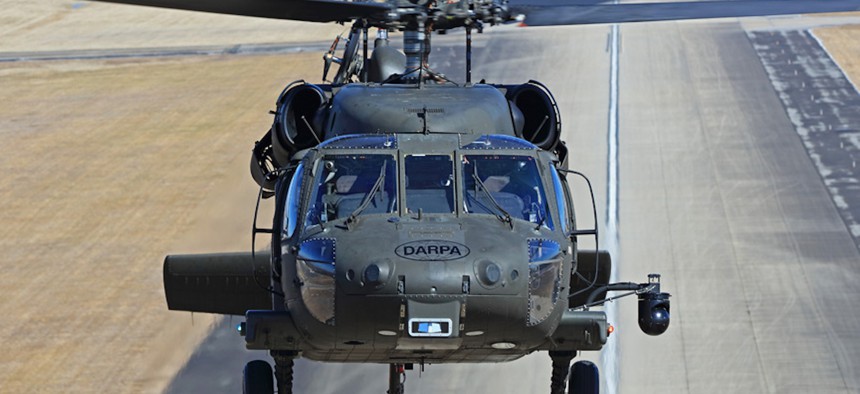Autonomous Black Hawk Tests Will Pave the Way For Future Unmanned Missions

An autonomous Black Hawk. DARPA
Software once designed to be a digital co-pilot is taking the wheel.
Going beyond previous unmanned helicopters that featured “advanced autopilots” or “the beginning of autonomy,” a new DARPA experiment showed off a pilotless Black Hawk rigged to carry out an entire mission based on a commander’s goals. Officials said the demonstration would help the Army, and other services, better figure out how they want to incorporate heavy, self-driving drones into future battle plans.
On Feb. 5, officials with the DARPA Aircrew Labor In-Cockpit Automation System, or ALIAS, program conducted two test flights with an UH-60A Black Hawk helicopter. “The pilots shifted the knob to zero and we did our first uninhabited flight,” Stuart Young, DARPA’s ALIAS program manager, told reporters on Tuesday.
The flight lasted about 10 minutes; maneuvering was largely limited to pedal turns. But a second, 30-minute flight took the aircraft “cross-country over the range here at Fort Campbell, Kentucky,” Young said.
That might not sound like a particularly important milestone, but previous attempts at helicopter autonomy were far more limited, Igor Cherepinsky, director of Sikorsky Innovations, told reporters.
For example, two Kaman K-MAX helicopters flew hundreds of resupply missions for the Marine Corps in Afghanistan, but that was more like a kind of advanced autopilot, Cherepinsky said. And in a 2015 experiment by the Army’s Tank Automotive Research Development and Engineering Center, or TARDEC, an unmanned UH-60 demonstrated what he called “kind of the beginning of autonomy.”
“Here we automated the entire aircraft,” including key pre-flight procedures such as power, secondary control, wind checks, and elements of adaptive flying, Cherepinsky said. “On this aircraft that we flew, if we would have lost an engine, the system actually would have handled it. Had [we] lost both engines, the system would have used LIDAR [Light Detection and Ranging] to pick the landing zone and [put] the aircraft down. So this is a truly an autonomous vehicle.”
It’s the difference between a pilot that can actually see and adapt to changing conditions versus an autopilot with neither of those features.
“The point here is if you look at the user interface, it's really specifying goals and constraints of the mission, right?” he said. “You're explaining to the aircraft what it is you want it to do. You're having a conversation, right?”
The software, Cherepinsky, said, was conceived to serve the role of a “digital copilot” but has since evolved. “Certainly it is and can be a digital copilot but with an operator on the ground. It really becomes a digital pilot and the human being on the ground becomes a mission commander.”
The ALIAS team is already getting interest in adapting the software for other types of aircraft, such as an F-16 for the Air Force.
“This is already flying on a large cargo aircraft. I’ll just say that,” he said.
The Army will be able to use the aircraft as part of its vertical-lift program to better understand what it wants future autonomous aircraft to do. That will inform not only future requirements but also the development of future tactics and techniques.
Said Young, “We have removed the safety net from our autonomous operations. We want to now provide that to the Army so that they can own it and use it on their own to develop autonomy requirements, more specifically how they would use autonomy on the future battlefield and enable them to have trust and develop that trust in operationally relevant environments.”






